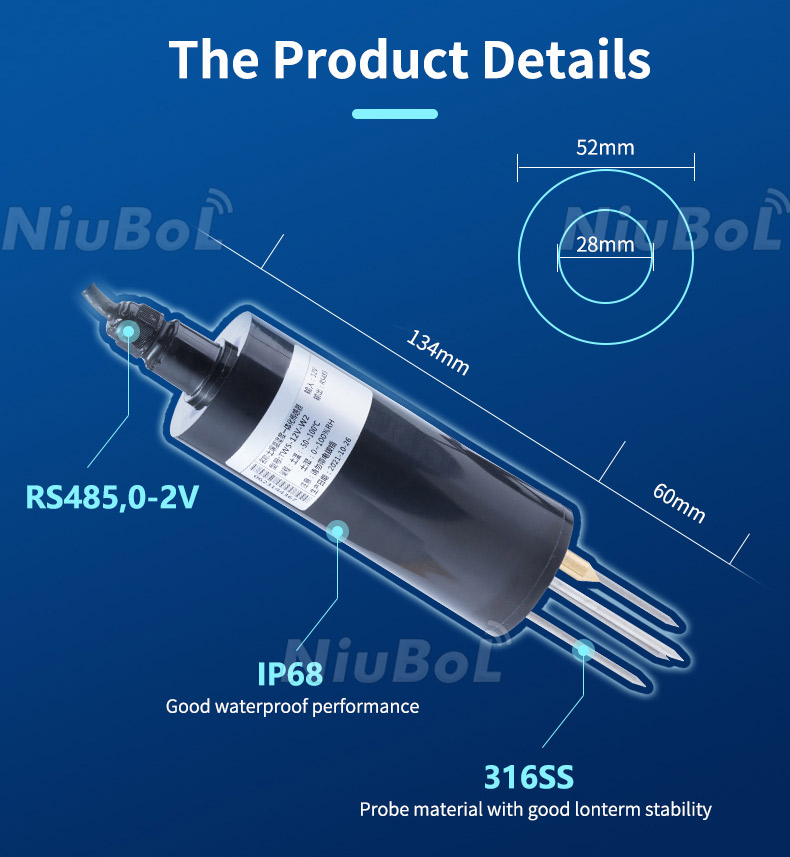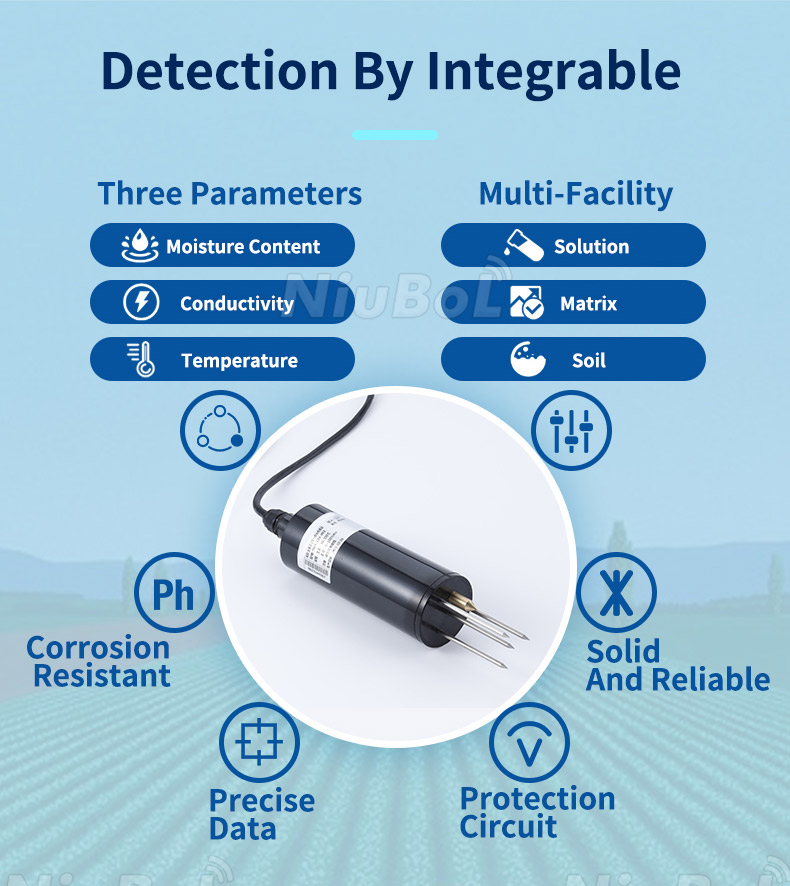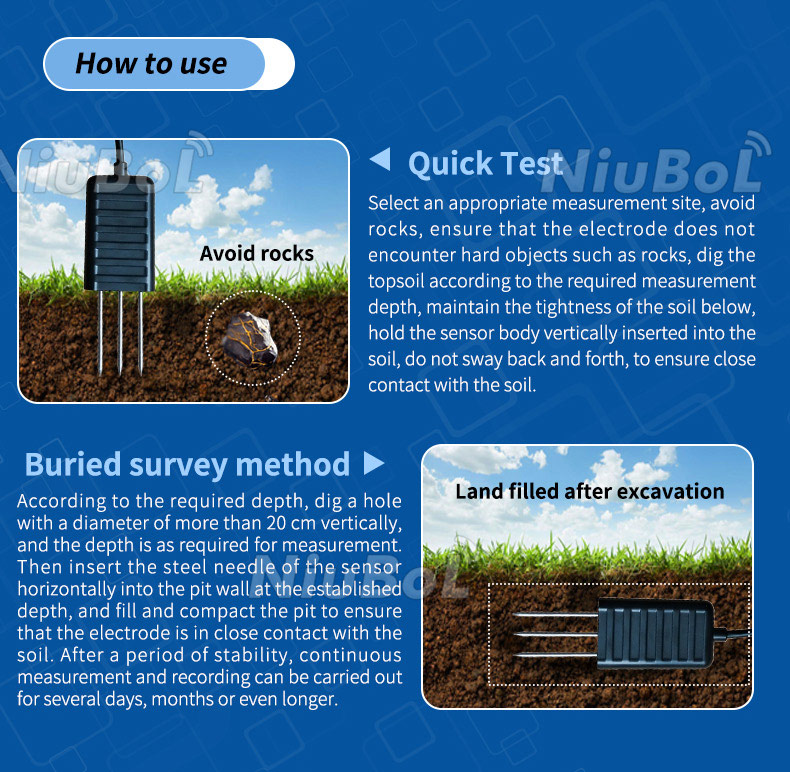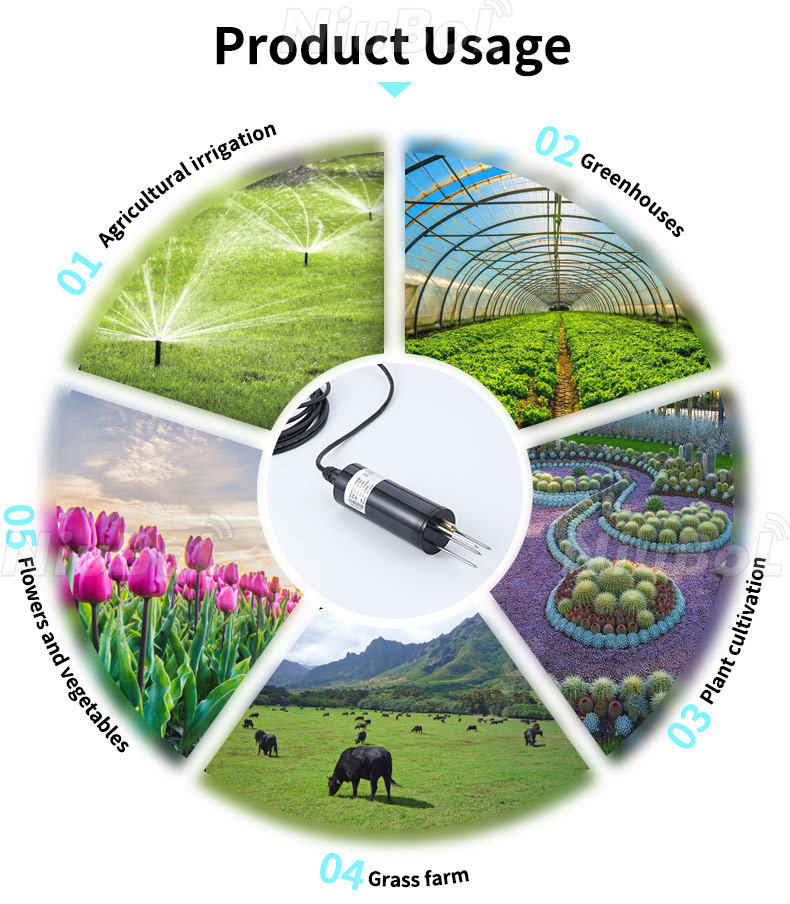

— Blogs —
—Products—
 Consumer hotline +8618073152920
Consumer hotline +8618073152920 WhatsApp:+8615367865107
Address:Room 102, District D, Houhu Industrial Park, Yuelu District, Changsha City, Hunan Province, China
Product knowledge
Time:2024-08-23 15:54:00 Popularity:691
FDR (Frequency Domain Reflectance) and TDR (Time Domain Reflectance) soil moisture sensors are two commonly used modern technologies for non-destructive measurement of moisture content in soil. They are based on the propagation properties of electromagnetic waves through the soil to assess the soil's dielectric constant and thus derive the soil's moisture content.
- Measuring principle: FDR sensors utilize the change in frequency of high-frequency electromagnetic waves to calculate the soil's dielectric constant. When electromagnetic waves propagate in media with different dielectric constants, their frequency response changes, and by analyzing these changes, the moisture content of the soil can be determined.
- Measuring Principle: TDR sensor sends a high frequency electromagnetic pulse along the transmission line into the soil, and calculates the dielectric constant based on the propagation time of the electromagnetic wave in the soil, and then obtains the moisture content.
TDR Soil Moisture Sensor vs FDR Soil Moisture Sensor:
The accuracy of FDR (Frequency Domain Reflectance) and TDR (Time Domain Reflectance) sensors performs differently in different soil types, which is mainly related to the physical characteristics of the soil, such as dielectric constant, salt content, density, etc.
- Tidal soils: In soils with high moisture content such as tidal soils, it has been shown that TDR soil moisture sensors may have a higher measurement accuracy than FDR.This may be due to the fact that the TDR technology is more adaptable to the soil conditions, especially under high moisture conditions.
- Red and black soils: In soils such as red and black soils, the measurement accuracy of FDR soil moisture sensors may be superior. This suggests that in specific types of soils, FDRs can provide a better match to soil properties, especially where dielectric constant variations are more complex.
- Universality: Overall, the TDR soil moisture sensor is considered to be more universal across a wide range of soil types, meaning that its performance is relatively stable across different soil conditions, but this may also be accompanied by higher cost and complexity.
- Influence of soil properties: The salinity, structure and organic matter content of the soil will affect the measurements of both sensors. the FDR, due to its principle of operation, may not be as sensitive as the TDR to changes in soil conductivity, which may be an advantage in highly saline soils.
- Calibration Requirements: With either technology, accuracy is dependent on proper soil calibration. Specific soil types may require specific calibration curves to ensure accurate measurements.
Therefore, when selecting an FDR or TDR soil moisture sensor for long-term or specific soil type monitoring, the specific characteristics of the soil should be considered and a targeted calibration may be required to ensure the most accurate data is obtained.
The reason that TDR (Time Domain Reflectance) sensors have higher measurement accuracy in moist soils than FDR (Frequency Domain Reflectance) may be related to the following factors:
1. sensitivity to changes in dielectric constant: damp soils typically have a high moisture content, which means that there are significant changes in the soil's dielectric constant. the TDR technique calculates the dielectric constant, and therefore the moisture content, by analyzing the propagation time of an electromagnetic wave through the soil. Under high moisture conditions, this direct measurement of time may be more sensitive to small changes in dielectric constant, providing a more accurate estimate of moisture content.
2. Compensation for Salt and Conductivity: The ability of the TDR Soil Moisture Sensor to independently measure the conductivity of the soil helps to correct moisture readings in high salinity environments, where tidal soils may contain high levels of soluble salts. By compensating for the effects of conductivity, the TDR can more accurately reflect moisture changes and avoid salt interference.
3. Handling of signal attenuation: In soils with high moisture content, the attenuation of electromagnetic waves may be different. By precisely controlling and analyzing the temporal characteristics of the reflected waves, the TDR technique can handle this attenuation better and maintain the accuracy of the measurement.
4. Adaptable: TDR soil moisture sensors are designed to handle complex soil conditions, and their adaptability to soil types and conditions may be more pronounced in extreme conditions such as tidal soils.
In contrast, FDR soil moisture sensors, while also providing highly accurate measurements in most situations, may suffer more from their performance under certain conditions, such as high moisture and potentially accompanying high conductivity, especially when subtle moisture changes need to be precisely differentiated. Therefore, in environments such as tidal soils, the measurement advantages of the TDR are even more pronounced.

The reasons for the cheaper price of FDR (Frequency Domain Reflectance) sensors versus TDR (Time Domain Reflectance) sensors are mainly related to technical complexity and component costs:
1. Technical simplicity: FDR soil moisture sensors utilize electromagnetic waves at a single frequency or a limited range of frequencies to measure the soil dielectric constant, which typically involves relatively simple electronic components and designs that do not require the complex pulse generators and high-speed data acquisition systems that are required for TDR.
2. Production cost: Since FDR works on a relatively simple principle, its production process may be easier to standardize and mass produce, which directly reduces the manufacturing cost.
3. Circuit design: The circuit design of FDRs typically does not require the processing of high-speed signals and precise time measurements, which means that lower-cost electronic components can be used.
4. Calibration and application: FDR soil moisture sensors may be designed to be more dependent on specific soil types, but this also means that they can be optimized for common conditions, reducing complexity and therefore cost.
5. Maintenance and operation: FDR soil moisture sensors are often designed to be more user-friendly, reducing the complexity and cost of long-term maintenance and operation.
6. Market positioning: The popularity of FDR soil moisture sensors and competition in the market may also lead to price reductions as more manufacturers are able to enter the market and offer diversified solutions.
In summary, the low-cost nature of FDR soil moisture sensors makes them an economical choice for a wide range of applications such as agriculture, horticulture, and environmental monitoring, although TDR may still be the preferred choice for certain applications where high precision is required.

1. Technical complexity: TDR technology relies on high-speed electronic components, including circuitry to generate precise pulses and high-speed data acquisition systems capable of rapidly sampling the reflected signal. These high-precision components are expensive to develop and manufacture.
2. High-frequency hardware: Because TDR operation involves sending and analyzing high-speed electromagnetic pulses, it requires the use of high-frequency transmission lines and matched impedance components, which are often expensive to manufacture.
3. Accuracy and Resolution: Highly accurate TDR systems provide finer impedance change detection, which typically requires more advanced hardware and more complex algorithms, which adds to the cost.
4. Software and Algorithms: TDR soil moisture sensors have complex back-end processing software that requires advanced algorithms to parse the reflected waveforms and determine impedance changes and locations, and software development and maintenance costs are also important components.

5. Integration and customization: Customized designs for specific applications, such as special environmental adaptations or data processing functions, can add additional R&D and production costs.
6. Economies of scale: Higher unit costs are associated with smaller production volumes because of the larger proportion of R&D and manufacturing fixed costs spread over each sensor.
7. Durability and reliability: High-quality TDR soil moisture sensors need to perform consistently in harsh outdoor or industrial environments, and the materials and packaging technologies used add to the cost.
8. After-sales service and support: High-end TDR equipment may be accompanied by more comprehensive after-sales service, including calibration, maintenance and user training, which will also affect the final price.
9. Market demand and competition: Market demand for high-precision TDRs and the state of competition among suppliers will also affect prices, but usually products with high technology content are priced higher.
In summary, the cost of TDR soil moisture sensors is not only related to the complexity of the technology itself, but also closely related to factors such as production scale, additional services, and market supply and demand.

To summarize
FDR and TDR each have their own advantages, and the choice of technology depends on the specific application needs, budget, and whether long-term continuous monitoring or stratified detailed data is required. fDR is widely recommended for its cost-effectiveness, ease of installation, and stability, while tdr is more appropriate where high-precision, stratified data is required. Both are indispensable tools in modern precision agriculture and environmental research.
NBL-S-THR-Soil-temperature-and-moisture-sensors-Instruction-Manual-V4.0.pdf
NBL-S-TMC-Soil-temperature-and-moisture-conductivity-sensor.pdf
Related recommendations
Sensors & Weather Stations Catalog
Agriculture Sensors and Weather Stations Catalog-NiuBoL.pdf
Weather Stations Catalog-NiuBoL.pdf
Related products
 Combined air temperature and relative humidity sensor
Combined air temperature and relative humidity sensor Soil Moisture Temperature sensor for irrigation
Soil Moisture Temperature sensor for irrigation Soil pH sensor RS485 soil Testing instrument soil ph meter for agriculture
Soil pH sensor RS485 soil Testing instrument soil ph meter for agriculture Wind Speed sensor Output Modbus/RS485/Analog/0-5V/4-20mA
Wind Speed sensor Output Modbus/RS485/Analog/0-5V/4-20mA Tipping bucket rain gauge for weather monitoring auto rainfall sensor RS485/Outdoor/stainless steel
Tipping bucket rain gauge for weather monitoring auto rainfall sensor RS485/Outdoor/stainless steel Pyranometer Solar Radiation Sensor 4-20mA/RS485
Pyranometer Solar Radiation Sensor 4-20mA/RS485
Screenshot, WhatsApp to identify the QR code
WhatsApp number:+8615367865107
(Click on WhatsApp to copy and add friends)